Suzan Mazur: Frank Carlucci I, "Sublime Prince"
Frank Carlucci I, "Sublime Prince"
By Suzan Mazur
The life of Frank Carlucci I has largely escaped public scrutiny, possibly because he's grandfather to one of the knights of the political chessboard -- Carlyle Group’s Frank Carlucci III -- who is not known for being flashy. But Carlucci I was an ebullient man and left a legacy as a master builder that merits attention, some of his projects including the Ellis Island Landing Station in New York Harbor, the Grand Stairway at Arlington National Cemetery and Washington D.C.’s Willard Hotel. Moreover, his life provides further insight into the political motivations of his grandson. [Click here: Scoop: Suzan Mazur: Unspooking Frank Carlucci]
His talent for secrecy in the Masonic brotherhood, for example, for which he was rewarded with the highest honor: “sublime prince of the royal secret” was no doubt coded somewhere in the Y chromosome passed along to Frank Carlucci III, who has so far served as deputy director of the CIA, secretary of defense and national security adviser, among other trusted appointments.
Carlucci I’s power base was his craft. As a third-generation Italian stone cutter, he was confident of his work. He was also a strikingly handsome man, sporting a handlebar moustache in an 1897 photo in the Portrait and Biographical Record of Lackawanna County, Pennsylvania.
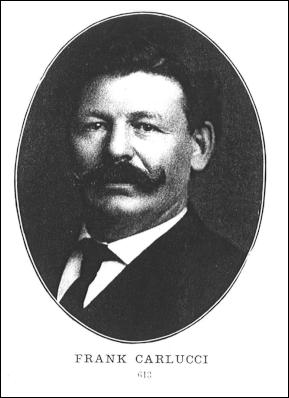
But to get a sense of what other forces shaped Carlucci I, you have to think your way back to another mythical age when medieval secret societies and ethnic fraternal organizations played a protective role in America’s emerging communities - as they did in the late 1800s in mineral-rich Scranton, Pennsylvania, where the Carlucci family settled after emigrating from Italy. Carlucci I belonged to them all - Masons, Knights Templar, Benevolent Protective Order of Elks, Mystic Shrine and Irem Temple Shrine.
He also served as honorary president for life of most, if not all, of the Italian societies in Scranton. Scranton had a large Italian immigrant population. The Italians came to the US seeking freedom and no more “padroni” (it’s unclear that’s what they got). Men generally worked in the anthracite coal mines and their families belonged to one of the Roman Catholic churches.
But Carlucci was a stone mason. Think Da Vinci Code for a moment. At the heart of Masonry and its occult rituals and symbols (a couple of which are stamped on US currency) is the building of the Temple of Solomon and fate of its master builder. Through the centuries this association with mysticism has put the Masons at odds with the Catholic Church, which has long rejected occult secret societies.
Carlucci obviously valued the traditions of his craft and professional associations, and the knowledge of the keystone in building an archway was part of the Mason success story. So, Carlucci opted for membership in St. Luke’s Episcopal church in Scranton. He also organized several Republican political clubs and served on various local councils.
Frank Carlucci I was born at Santomenira, Italy near Salerno on April 7, 1862 - according to northeast Pennsylvania historian, Joseph H. Young, who retrieved Lackawanna county documents. He was the son of Carlo and Grace (Napoliello) Carlucci and the grandson of John Angelo Carlucci.
Frank I took up stone cutting at age 14 in Italy. And in 1882 at age 20, he emigrated to the US with his brother Nick Carlucci. There were nine children altogether and the family reunited in Scranton where a number of Carlucci descendants still live.
Frank first worked in Scranton with a German building contractor named Conrad Schroeder, leaving the firm in 1884 to form a cut stone partnership with Nick - Frank Carlucci & Brother, then F&N Carlucci. In 1900, F&N Carlucci merged with Schroeder, reorganizing as The Carlucci Stone Company.
The Carluccis advertised as wholesale dealers and general contractors in cut stone and cut stone buildings. They dealt in limestone, bluestone, pink granolithic sandstone and crushed stone. This was before the widespread use of cinder blocks in building. Schroeder remained president of the company until his death two years later from an accidental self-inflicted gunshot wound.
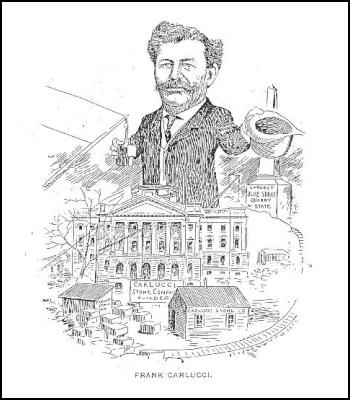
The Carlucci stoneyards were conveniently situated in Scranton close to the Delaware, Lackawanna & Western railroad, which enabled Carlucci to transport stone throughout the country. He tapped the company’s sandstone quarries at nearby Nicholson and Forest City, and cut and dressed the stone in his stoneyards. He collaborated with such architects as Lansing Holden, Fred Amsden, Ed Langley and others to build dozens of landmarks in northeastern Pennsylvania and elsewhere in the keystone state, among them: the Luzerne and Monroe county courthouses, a post office, five Protestant churches, the Lackawanna county jail (built with Schroeder), Coal Exchange Building (with Schroeder), several hotels, the Scranton Republican Building, the FM Kirby residence, CS Woolworth residence.
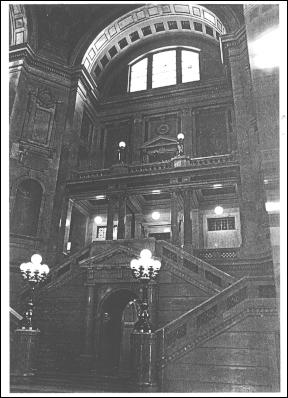
Interior Luzerne County Courthouse
Photo: Lackawanna Historical Society
The sandstone Carlucci used first formed in the upper Lackawanna River about 365 million years ago. It was greenish gray (bluestone) that went into the 1890 construction of Ellis Island Landing Station in New York Harbor. Carlucci secured a $250,000 government contract for the job. He also built his own home in stone at Clay Avenue and Poplar Street - a classic Greek temple with pillars, where he lived with his Swiss wife, Louise Cerine and children Frank Jr., Carl, Helen and Althea.
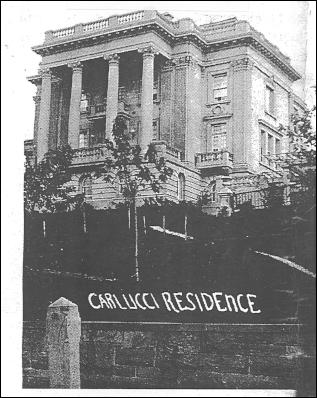
Photo: Lackawanna Historical Society
Carlucci maintained contact with the pool of artisans in southern Italy where he grew up, some of whom he brought to Scranton. He started a School of Mechanics and Arts in Scranton to train stonecutters. He also published the only Italian newspaper at the time in northeastern Pennsylvania, the Pensiero (Thought).
In celebration of the 400th anniversary of Christopher Columbus’s discovery of America, Carlucci proposed erecting a Columbus monument in Scranton’s Courthouse Square. Italian sculptor Albini Cottini drew the model for Columbus and Carlucci carved it from a 9½ foot block of solid limestone. The statue still stands on the square where Carlucci spoke at the October 11, 1892 unveiling.
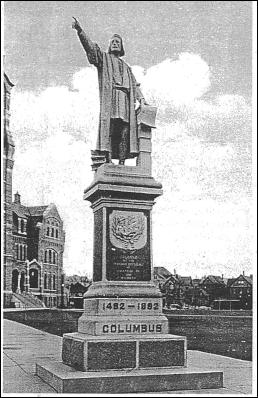
Photo: Lackawanna Historical Society
In an encore in 1893, Carlucci carved a statue of George Washington for the square. According to Mary Ann Moran, director of the Lackawanna Historical Society who has been studying the Carlucci monuments, the night of the Washington statue dedication a theater benefit was held entitled “The Voodoo or the Lucky Charm”, which seems to say something about the life of Carlucci .
One of his most talented proteges was Vincent Russoniello. Russoniello’s archives at Philadelphia’s Historical Society of Pennsylvania reveal he toughed it out at Carlucci's Nicholson quarry for 22 cents an hour, later moving on to an unpaid apprentice-architect position at the stoneyard office as a result of family connections to the Carluccis through the Cassesse banking family, which he would eventually marry into:
"The thing was all in the [family]. Cassesse was a brother-in-law to Carlucci. So my father and my mother talked to Carlucci's father. Carlucci's father talked to his son, so finally they sent me from Nicholson [quarry].…. The reason why, I used to get $15 a month at Nicholson. I used to pay $12.00 a month for board so I had $3.00 left. The fare would take care of that, so I was working practically for nothing.
…. See Nicholson was bluestone and here [in the stoneyard] it was mostly limestone, cut stone, corner and what not. It was hard work . . . they used to send me on this job.
…. I'll never forget it. . . . It was winter time and the snow was melting and as I was cutting the hole [on the cornice of a school for the leader to go through] I was getting sick, fever, and then . . . after a lot of pull here and there, they finally gave me a little job in the office."
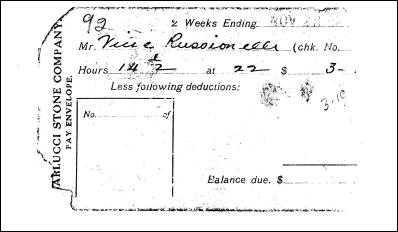
Russoniello later opened his own firm in Scranton, building many of the Roman Catholic churches in the region using Carrara marble, plus various properties for prominent businessmen including Frank Carlucci I, lawyer John Memolo and industrialists Philip and Angelo Medico.
In 1913 Carlucci’s eyesight began to fail. There was a financial crash around this time and banks were closing, including the Cassesse Bank. Carlucci left the stone cutting business and was forced to sell his home on Clay & Poplar; it was eventually demolished.
From 1921 until his death a decade later, he was a coal operator/contractor. His son, Frank Carlucci, Jr., would take a more secure path as an insurance agent for Connecticut Mutual and move his family to the woods at Bear Creek following the death of his first wife. Frank Carlucci I died March 4, 1931 at the age of 69, several months after the birth of his grandson and namesake, Frank Carlucci III.
Suzan Mazur's reports have appeared in the Financial Times, Economist, Forbes, Newsday, Philadelphia Inquirer, among other publications, and on PBS, CBC and MBC. She has been a guest on McLaughlin, Charlie Rose, and various Fox television news shows. Email: sznmzr@aol.com


 Gordon Campbell: On Free Speech And Anti-Semitism
Gordon Campbell: On Free Speech And Anti-Semitism Ian Powell: The Disgrace Of The Hospice Care Funding Scandal
Ian Powell: The Disgrace Of The Hospice Care Funding Scandal Binoy Kampmark: Catching Israel Out - Gaza And The Madleen “Selfie” Protest
Binoy Kampmark: Catching Israel Out - Gaza And The Madleen “Selfie” Protest Ramzy Baroud: Gaza's 'Humanitarian' Façade - A Deceptive Ploy Unravels
Ramzy Baroud: Gaza's 'Humanitarian' Façade - A Deceptive Ploy Unravels Keith Rankin: Remembering New Zealand's Missing Tragedy
Keith Rankin: Remembering New Zealand's Missing Tragedy Gordon Campbell: On Why The Regulatory Standards Bill Should Be Dumped
Gordon Campbell: On Why The Regulatory Standards Bill Should Be Dumped